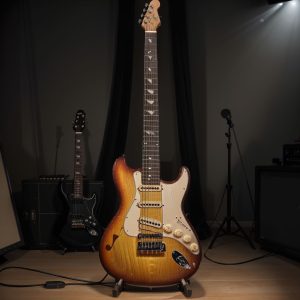The electric guitar is one of the most iconic instruments in modern music, influencing countless genres and shaping the sound of the 20th and 21st centuries. The evolution of music has been deeply intertwined with technological advances, and the electric guitar played a central role in this transformation. Prior to its invention, guitars were strictly acoustic, relying on hollow bodies to amplify sound through the vibration of strings. However, the limitations of acoustic guitars in loud, amplified environments, particularly in large orchestras or big-band settings, led to the search for a solution that would allow the guitar to be heard above the din.
In the 1920s, engineers began experimenting with electronic pickups, which converted the vibrations of the guitar strings into electrical signals that could then be amplified. The first significant leap came in 1931 when George Beauchamp and Adolph Rickenbacker created the “frying pan,” the first commercially successful electric guitar. This marked a major turning point in the history of music, as it allowed guitarists to explore new sounds and techniques that were previously impossible on acoustic instruments. The electric guitar opened up a world of possibilities, from rock ‘n’ roll’s rebellious attitude to jazz’s intricate improvisations.
Throughout the 1940s and 1950s, the electric guitar continued to evolve. The introduction of solid-body designs by Fender and Gibson in the mid-20th century transformed the instrument’s stability and sound. These new models, such as the Fender Stratocaster and the Gibson Les Paul, became staples in rock, blues, and pop music, defining the sound of iconic artists like Jimi Hendrix, Chuck Berry, and B.B. King. As rock ‘n’ roll exploded onto the scene in the 1950s, the electric guitar became the driving force behind the genre’s powerful energy and raw emotion.
By the 1960s and 1970s, the electric guitar had firmly established itself as the voice of rebellion and creative freedom. With the rise of psychedelic rock, punk, and heavy metal, guitarists pushed the boundaries of sound with new effects and distortion techniques. Guitar solos became anthems of self-expression, with legendary players like Jimmy Page, Eric Clapton, and Eddie Van Halen creating some of the most memorable moments in rock history.
Today, the electric guitar continues to evolve. Modern advancements, including digital effects, multi-channel amplifiers, and wireless technology, have pushed the boundaries of what is possible. The electric guitar has adapted to fit the demands of contemporary music, whether it be in the hands of a classic rocker or a cutting-edge electronic producer. What began as a simple attempt to amplify a guitar has become one of the most versatile and influential instruments in history, shaping the sound of virtually every music genre.
The electric guitar’s journey from humble beginnings to its current state of innovation is a testament to the power of human creativity and the desire to break boundaries. Its place in music is secure, and it will continue to inspire future generations of musicians to push the limits of sound, expression, and art.

